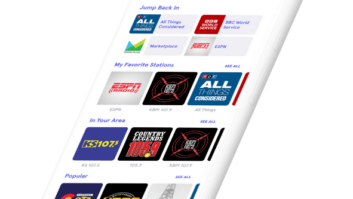Alternative community radio station KEXP in Seattle is moving to a new broadcast complex at the Seattle Center Campus in the heart of Seattle�s arts core.
This conceptual drawing highlights the station�s downtown location. Affiliated with the University of Washington, KEXP has been a staple of Seattle�s music scene for over 40 years and will soon occupy a 28,000-square-foot facility in Seattle Center�s Northwest Rooms Building, dating from the 1962 World�s Fair.

KEXP has kicked off project to expand and upgrade their facility, which will be a gathering space for the whole community and will allow KEXP to expand their programming, forge new partnerships, continue to innovate and better support artists. Renovation on the building began in January 2015, targeting a scheduled move to the new space at the end of this year. Funds for the new facility were raised by an on-air campaign, augmented by foundation, corporate, local entrepreneur and local government support.
DESIGN
Programs at KEXP range from live air-shifts to live concerts to curating music artistry. The station broadcasts over-the-air at 90.3 MHz. and also via the Internet, providing additional live video feeds of the shows online.
The main entrance already features station branding. The KEXP redesign project began when design firm Walters-Storyk Design Group and KEXP sat down and defined the scope of the project. Questions such as �how many studios?� and �what kind of equipment?� were discussed at the outset. Walters-Storyk then created architectural drawings, basic systems one-line drawings and acoustical designs.

Live music performances are an important element of the station�s format. The building layout was designed with musician and engineer needs in mind while simultaneously considering fan comfort and line-of-sight. The 28,000-square-foot footprint includes a 1,100-square-foot live room performance space with an adjacent area for audiences of up to 50 attendees.
The new technical facilities will include:
� 400-square-foot on-air studio
� 1090-square-foot live room
� two production rooms
� two audio and two DJ Booths
� video edit rooms
� video control room
� two DJ Iso rooms
� a green room
� production/mastering
� open office space
� a library
� conference rooms
� a 4,500-square-foot reception area/audience space with a stage for live performances, adjacent to a record/retail store and a caf�.
Systems Integrator Mizzen Media (of Los Angeles and Nashville) has been retained by KEXP to assemble the new technical facility. Mizzen�s management team has experience in large facilities projects, including NBCUniversal, DirecTV, Univision Radio of Los Angeles and Post Perfect in New York.
�The complete Mizzen shop drawing package includes conduit and connection box layouts, custom pin-outs, connectors, wire run lists, cable labels, a complete set of video, audio, control diagrams, rack elevations with heat loads, running/start-up power, floor loading and UPS configurations,� says Mizzen Media Director of Engineering and Consulting Patrick Howley,
Other design professionals are involved in the KEXP project, including SKB Architects and Sellen Construction, and the project manager is Costigan Integrated.
SYSTEMS DESIGN
Just how do you build and test the new KEXP station while some of the equipment is still being used at the old facility? The answer is planning … with a lot of design detail and the documentation to back it up.
This summer, construction began on the new facility.

To facilitate the design process, Mizzen Media has developed a powerful set of tools built on the AutoCAD platform. Co-founders Brad Murphree and Matt Hogan developed the company�s systems design automation program: Robotic Operational Build, known colloquially as ROB. This workflow tool was created to automate the engineering design process and has been utilized in every project completed.
Mizzen Media creates template-based, semi-automated engineering drawings that are used to create a final drawing set. Once the detailed design is complete, Mizzen utilizes their software to extract detailed metadata from the engineering drawings to automatically populate wire run lists, cable labels and perform various calculations including power requirements, weight, heat loads, etc. This program is also backwards compatible, so mass changes can be made across the drawing set and deliverables reports without even having to open AutoCAD.
At the end of the KEXP kick-off meeting, Murphree documented the existing rack elevations with the ROB software and worked with KEXP Chief Engineer Jamie Alls to validate the existing connection drawings. Mizzen then began the process of refining the design of the new space by starting with CAD files created by the Walters-Storyk Group.
�Using our proprietary software, we began to overlay the conduit drawings, roof penetrations and then refined the furniture design to accommodate some equipment changes,� says Murphree. �The connection drawings were next and some workflow issues were worked out while they were being done.�
The KEXP design package isn�t just a bundle of drawings and lists, but is the net result of an important exercise � building the facility on paper first. And the design package isn�t used just in the design and construction phases of the project, but also in the commissioning and testing stages.
VIDEO IN RADIO
The new facility includes video edit rooms. In 2014 KEXP recorded 380 events/concerts and live streamed over one-third of those. The new facility will improve their ability to record video and stream the concerts, and in addition, the stage area will allow the public to participate.
The video system consists of pan/tilt/zoom cameras in fixed locations, complemented with operated handheld or tripod hard-mounted cameras. All video lines home run to a central video matrix and production switcher to be controlled from the video control room.
CHALLENGES
There were many exciting challenges with KEXP�s project but two were of particular interest.
First, the radio station currently has 47 DJs. Engineers will be transitioning and training them in new technology, while making the changeover without scheduled downtime.
Second, each air talent has his or her own specific, personalized studio setup, so a system was created that is standardized yet simple and easy to manipulate and configure (intercom setups, etc.) The DJs have also been �hand spinning� their selections and the new workflow involves Dalet asset management with an interface to the Wheatstone products.
With building remodeling started, the next step is to finalize the integration plan, order equipment and other materials and then start assembling the gear. Installation began this summer.
What kind of equipment will KEXP be using? How did they get a jump on assembling racks and wiring equipment before building construction is complete? Will KEXP use the Space Needle as a broadcast tower? That�s up next.












